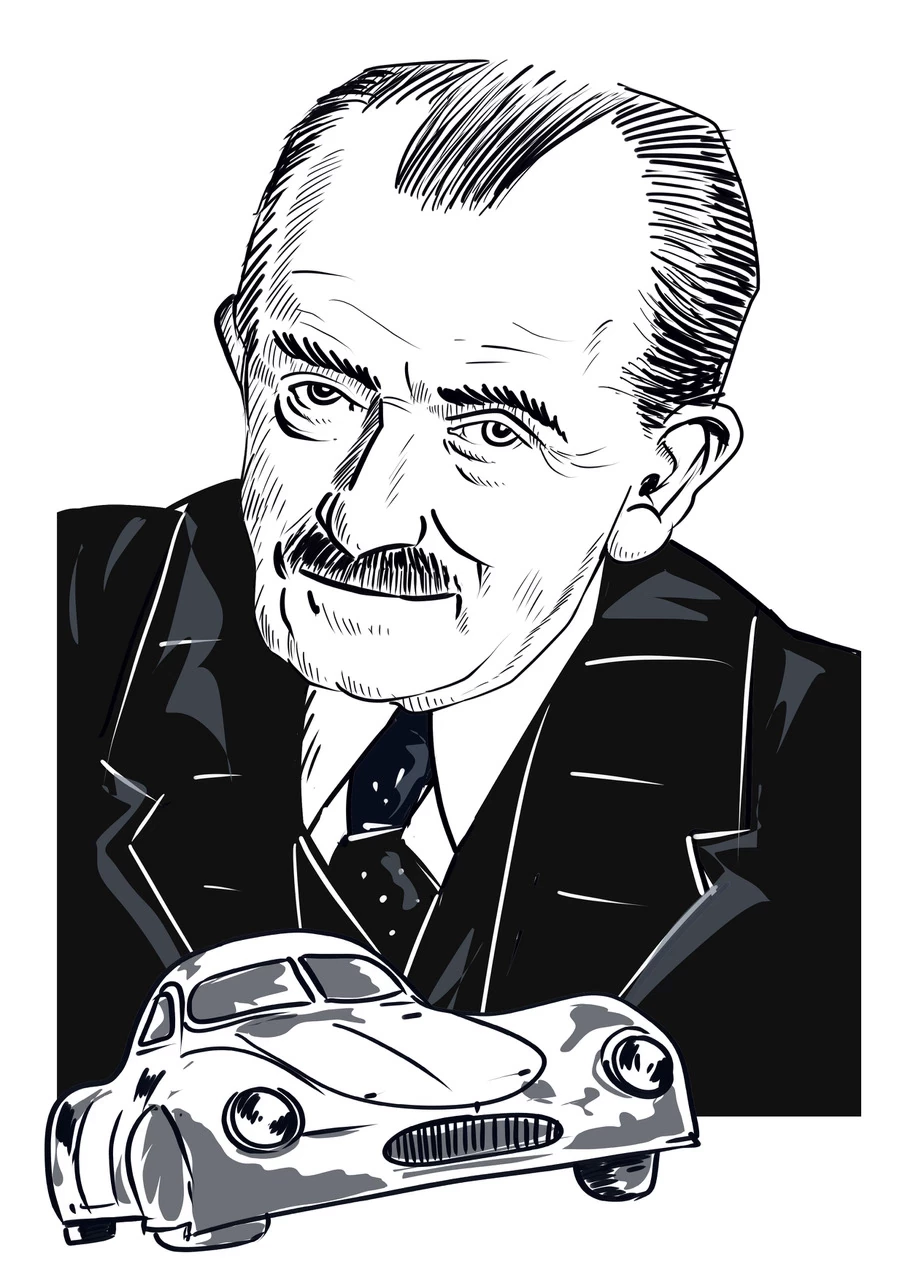The Not So Fast Lane
With Relentless Pursuit, Ferdinand Porsche Crafted His Dream Into An Automotive Icon.


FERDINAND PORSCHE, a name synonymous with automotive excellence, once famously said, “I couldn’t find the sportscar of my dreams, so I built it myself.” This declaration encapsulates the essence of Porsche’s legacy—a brand that has become a benchmark for engineering prowess, entrepreneurial spirit, and enduring quality. From humble beginnings to global acclaim, the journey of Ferdinand Porsche is a testament to the relentless pursuit of perfection and innovation.
Porsche cars are celebrated worldwide for their mechanical coherence, a direct result of Ferdinand Porsche’s unparalleled engineering skills. His meticulous approach to car design pushed the boundaries of technology and performance, establishing Porsche as not only a premier car manufacturer but also a research and development powerhouse. His early 20th-century career began with the development of the Lohner-Porsche, a hybrid vehicle that combined an internal combustion engine with electric motors. Despite facing significant challenges, including technical difficulties and market resistance, Porsche’s innovative spirit remained undeterred.
Born in 1875 in Maffersdorf, Austria-Hungary, Porsche’s fascination with technology and mechanics was evident from an early age. His professional journey saw him working with several prominent automotive companies, including Austro-Daimler and Mercedes-Benz. These experiences honed his engineering expertise but did not quench his dream of creating a sportscar that embodied his vision of performance and design.
In 1931, Porsche founded his engineering consulting firm in Stuttgart, Germany. Initially focused on developing automotive technologies for other manufacturers, Porsche’s passion for creating his sportscar persisted. The outbreak of World War II saw Porsche’s company involved in producing military vehicles, including the iconic Volkswagen Beetle. This period provided valuable experience and resources, setting the stage for the realization of his dream post-war.
Facing financial difficulties and political restrictions after the war, Ferdinand Porsche and his son, Ferry Porsche, unveiled the Porsche 356 in 1948—the first car to bear the Porsche name. This lightweight, agile sportscar quickly gained a reputation for its exceptional reliability and engineering. The 356’s success laid the foundation for Porsche’s future triumphs, but it was the introduction of the Porsche 911 in 1963 that truly solidified the brand’s reputation. The 911’s unique rear-engine layout and elegant yet functional design have undergone numerous iterations, each incorporating the latest technological advancements while staying true to its original spirit.
Porsche’s dedication to engineering excellence has led to several pioneering innovations, such as turbocharging technology, advanced aerodynamics, and cutting-edge suspension systems. These innovations have not only enhanced the performance of Porsche vehicles but have also influenced the broader automotive industry. The brand’s commitment to continuous improvement ensures that every model—from early designs to the latest electric and hybrid models—sets new standards in performance, safety, and efficiency.
Ferdinand Porsche’s journey from dream to reality exemplifies entrepreneurial brilliance. Transforming an idea into a profitable venture required not just hard work but strategic thinking. His story is one of resilience and innovation, qualities that have defined the Porsche brand for decades. Building a car from scratch demands a unique blend of creativity, technical knowledge, and relentless determination—qualities that Ferdinand Porsche embodied, driving his vision forward with an unwavering commitment to excellence.
The early years were challenging for Porsche. Financial constraints and the need to establish a brand identity in a competitive market required strategic planning and resourcefulness. Ferdinand and Ferry Porsche worked tirelessly to refine their designs, improve manufacturing processes, and build a loyal customer base. Their perseverance paid off as the Porsche 356 gained popularity among enthusiasts and racers alike, providing the financial stability needed for further research and development.
One of the most remarkable aspects of Porsche’s legacy is its sustainability. Over 70% of all Porsches ever built since 1948 are still on the road today. This statistic, one of the highest in the automotive industry, underscores the durability and quality of Porsche vehicles. This longevity not only highlights the brand’s engineering excellence but also its commitment to building cars that stand the test of time. Porsche’s focus on sustainability extends beyond the longevity of its vehicles to include reducing environmental impact through innovative technologies and manufacturing practices. The development of hybrid and electric models combines the brand’s performance heritage with cutting-edge powertrain technology.
Ferdinand Porsche’s legacy offers valuable insights into the power of self-confidence and the importance of taking control of one’s destiny. His story encourages us to embrace calculated risks and pursue our dreams with passion and determination. Porsche’s ability to balance risk and innovation allowed him to create a brand that has stood the test of time. His success was not a result of reckless ambition but of carefully considered decisions and a deep understanding of engineering and market dynamics. Ferdinand Porsche created more than just a car brand; he built a legacy that continues to inspire and influence the automotive industry and beyond. His story is a powerful reminder that with passion, perseverance, and a willingness to embrace challenges, we can turn our dreams into reality.
The views and opinions expressed herein are the views and opinions of the author and do not necessarily reflect those of The Monegasque™.
Disclosure: The Monegasque™ enhances the editing process with the help of carefully selected AI tools. These tools provide valuable support without taking over the editing process completely, ensuring that the final product is the result of human creativity and expertise augmented by the benefits of enhanced technology. This article is protected under the copyright of The Monegasque™. Unauthorized reprinting, republishing, or rewriting of this content is strictly prohibited without explicit permission from The Monegasque™. Quotations from this material are permissible provided that a direct link to the full article on The Monegasque™ is included.